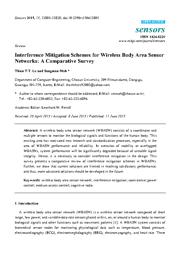Interference Mitigation Schemes for Wireless Body Area Sensor Networks: A Comparative Survey
Thien Le, Sangman Moh
2015
Sensors
A wireless body area sensor network (WBASN) consists of a coordinator and multiple sensors to monitor the biological signals and functions of the human body. This exciting area has motivated new research and standardization processes, especially in the area of WBASN performance and reliability. In scenarios of mobility or overlapped WBASNs, system performance will be significantly degraded because of unstable signal integrity. Hence, it is necessary to consider interference mitigation in the
more »
... ign. This survey presents a comparative review of interference mitigation schemes in WBASNs. Further, we show that current solutions are limited in reaching satisfactory performance, and thus, more advanced solutions should be developed in the future. Sensors 2015, 15 13806 sensors may be wearable or implanted devices that collect and transmit vital signals to the coordinator. The collected data can then be forwarded to a hospital for medical purposes. The applications of WBASNs can be categorized into two main fields: (1) medical applications that include remote patient monitoring, rehabilitation, biofeedback, and assisted living and (2) nonmedical applications that include fitness, performance and wellness monitoring, biometrics, and notification management [2] . Of course, for the medical and healthcare applications of WBASNs, the quality and continuity of signals are extremely important. However, radio propagation in WBASNs is dynamic due to the mobility of a human body, and different human tissues may be affected differently by biosensor signals. It is clearly shown in [3] that the quality of signals is affected by the propagation around the human body in accordance with channel models. Also, the effect of different kinds of human tissues to lossy signals is shown in the frequency range between 10 kHz and 1 GHz. In [4] , the requirements of WBASNs based on the IEEE 802.15.6 standard are summarized as follows: the bit rate of a link is in the range of 10 kbps to 10 Mbps, packet error rate should be less than 10% for a 256 octet payload for 95% of links, and the time to join or leave a network is less than 3 s. The communication architecture of WBASNs is divided into three tiers: intra-WBASN communication (tier 1), inter-WBASN communication (tier 2), and beyond-WBASN communication (tier 3). Two standards, IEEE 802.15.4 [5] and IEEE 802.15.6 [1], cover WBASN technology. The IEEE 802.15.4 standard defines the physical (PHY) and medium access control (MAC) specification for low-rate wireless personal area networks at short range (up to 100 m) [5]. The IEEE 802.15.6 standard defines the PHY and MAC layers for WBASNs in short-range wireless communication within, on, or around the human body [1]. More specifically, the IEEE 802.15.4 standard is implemented into a specific application of IEEE 24451 standard [6]. The real application is a neurorecording system that aims to collect data of patients. The system consists of electrodes and a wireless module. The electrodes collect EEG signals of human head, and the wireless module uses different communication standards. In this application, three communication standards of IEEE 802.11, IEEE 802.15.1 and IEEE 802.15.4 are used. Furthermore, the MAC protocols of the two standards are compared in [7] , where it is concluded that IEEE 802.15.6 is superior to IEEE 802.15.4 in terms of packet loss ratio, average delay, and network throughput. It is also shown that IEEE 802.15.6 carrier sense multiple access with collision avoidance (CSMA/CA) consumes more energy than IEEE 802.15.4 CSMA/CA. In [7], the design challenges of WBASNs are addressed, focusing on the MAC protocol, radio channel, and power consumption. A WBASN is set up for an individual human body, and therefore, in many practical environments multiple WBASNs are unavoidable. Moreover, the human body is mobile, and the sensor devices associated with arms, legs, et al., on a human body are also mobile within a limited range. In such operation conditions, intra-WBASN and inter-WBASN interference may severely impair transmission. Therefore, in scenarios involving mobility or overlapped WBASNs, unstable signal integrity may spatially and temporally degrade network performance. For example, in a hospital environment, where many WBASNs are used for medical purposes, nearby WBASNs or other equipment operating at the same frequency band cause interference, and the lost signals may lead to a dangerous situation in the medical systems. Hence, it is considerably necessary to consider interference mitigation in the design. WBASN interference can be categorized into three types: (1) Intra-WBASN interference occurs among sensor nodes within the same WBASN; (2) inter-WBASN interference occurs among WBASNs working at the same frequency band; and (3) inter-domain interference or cross-interference
doi:10.3390/s150613805
pmid:26110407
pmcid:PMC4507660
fatcat:icljfox74vgprguek5qvwtag5y

